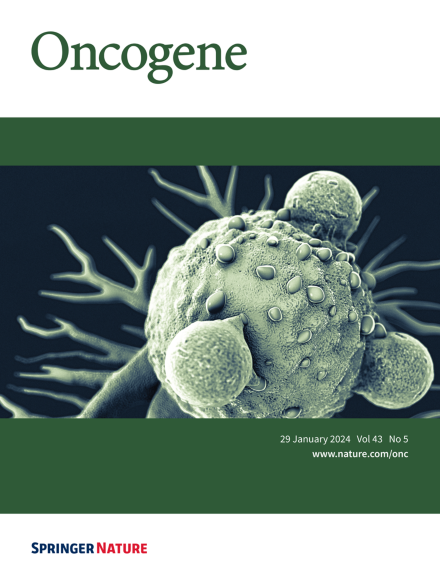在髓性白血病细胞中,β-Catenin与包括MSI2在内的典型rbp相互作用,与Wnt信号mRNA网络相关联。
IF 7.3
1区 医学
Q1 BIOCHEMISTRY & MOLECULAR BIOLOGY
引用次数: 0
摘要
Wnt/β-catenin信号传导对于正常造血干细胞/祖细胞(HSPC)生物学非常重要,并与急性和慢性髓性白血病(AML和CML)密切相关。中心介质β-连环蛋白是髓系肿瘤的一个有吸引力的治疗靶点,但由于其在造血细胞中的分子相互作用特征不明确,其靶向性受到阻碍,这将不同于其在实体组织中的网络。我们之前的β-catenin相互作用组研究发现了rna结合蛋白(RBP)的显著富集,这意味着β-catenin在髓细胞中具有转录后作用。为了鉴定β-catenin相互作用的mrna,我们进行了β-catenin rna免疫沉淀结合rna测序(RIP-seq),并鉴定了显著富集的Wnt信号通路转录本。利用β-catenin交联免疫沉淀(CLIP),我们证明了β-catenin直接结合RNA的能力有限,这意味着它依赖于其他rbp。在骨髓细胞系和原发性AML患者样本中发现β-Catenin与Musashi-2 (MSI2)相互作用,其中表达显著相关。MSI2敲低通过抑制LEF-1表达和核定位减少Wnt信号输出(TCF/LEF活性)。通过RIP和CLIP,我们证明MSI2以部分依赖于β-catenin的方式结合LEF1 mRNA,并可能影响LEF1表达的转录后控制。最后,我们发现msi2介导的人类HSPCs的扩增可以部分通过LEF1调控来驱动。这是首次通过实验证明人类细胞中MSI2和Wnt信号之间的功能性串扰,并表明β-catenin在血液学背景下可能具有新的转录后作用。本文章由计算机程序翻译,如有差异,请以英文原文为准。

β-Catenin interacts with canonical RBPs including MSI2 to associate with a Wnt signalling mRNA network in myeloid leukaemia cells
Wnt/β-catenin signalling is important for normal hematopoietic stem/progenitor cell (HSPC) biology and heavily implicated in acute and chronic myeloid leukaemia (AML and CML). The central mediator β-catenin is an attractive therapeutic target in myeloid neoplasms however its targeting has been hampered by a poor characterisation of its molecular interactions in haematopoietic cells, which will differ from its network in solid tissues. Our previous β-catenin interactome study identified the significant enrichment of RNA-binding proteins (RBP) implying post-transcriptional roles for β-catenin in myeloid cells. To identify β-catenin interacting mRNAs we performed β-catenin RNA-immunoprecipitation coupled to RNA-sequencing (RIP-seq) and identified significantly enriched Wnt signalling pathway transcripts. Using β-catenin cross-linking immunoprecipitation (CLIP) we demonstrated a limited capacity for β-catenin to bind RNA directly, implying dependence on other RBPs. β-Catenin was found to interact with Musashi-2 (MSI2) in both myeloid cell lines and primary AML patient samples, where expression was significantly correlated. MSI2 knockdown reduced Wnt signalling output (TCF/LEF activity), through suppression of LEF-1 expression and nuclear localisation. Through both RIP and CLIP we demonstrate MSI2 binds LEF1 mRNA in a partly β-catenin dependent fashion, and may impact the post-transcriptional control of LEF-1 expression. Finally, we show that MSI2-mediated expansion of human HSPCs could be partly driven through LEF1 regulation. This is the first study to experimentally demonstrate functional crosstalk between MSI2 and Wnt signalling in human cells, and indicates potential novel post-transcriptional roles for β-catenin in a haematological context.
求助全文
通过发布文献求助,成功后即可免费获取论文全文。
去求助
来源期刊

Oncogene
医学-生化与分子生物学
CiteScore
15.30
自引率
1.20%
发文量
404
审稿时长
1 months
期刊介绍:
Oncogene is dedicated to advancing our understanding of cancer processes through the publication of exceptional research. The journal seeks to disseminate work that challenges conventional theories and contributes to establishing new paradigms in the etio-pathogenesis, diagnosis, treatment, or prevention of cancers. Emphasis is placed on research shedding light on processes driving metastatic spread and providing crucial insights into cancer biology beyond existing knowledge.
Areas covered include the cellular and molecular biology of cancer, resistance to cancer therapies, and the development of improved approaches to enhance survival. Oncogene spans the spectrum of cancer biology, from fundamental and theoretical work to translational, applied, and clinical research, including early and late Phase clinical trials, particularly those with biologic and translational endpoints.
 求助内容:
求助内容: 应助结果提醒方式:
应助结果提醒方式:


